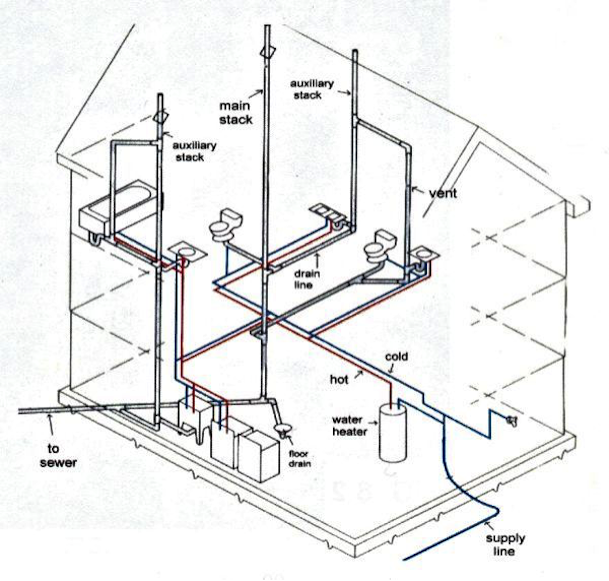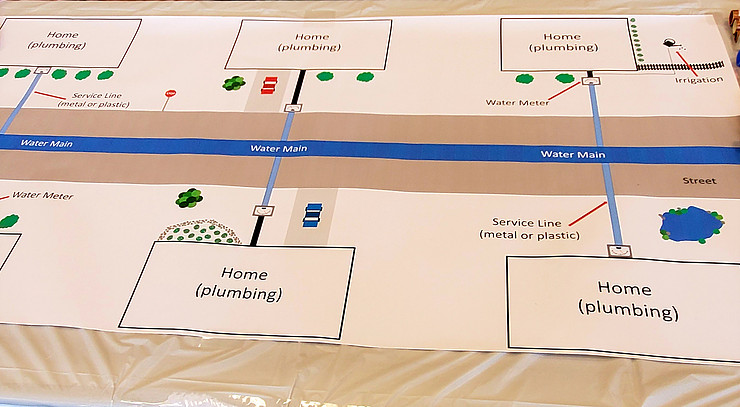Design of Your Home's Plumbing System: What It Matters
Design of Your Home's Plumbing System: What It Matters
Blog Article
How do you really feel on the subject of The Inner Workings of Your Home's Plumbing?

Comprehending just how your home's pipes system works is necessary for every single property owner. From providing clean water for alcohol consumption, cooking, and bathing to safely eliminating wastewater, a well-maintained plumbing system is critical for your family's health and comfort. In this thorough overview, we'll explore the elaborate network that makes up your home's pipes and offer pointers on maintenance, upgrades, and taking care of typical concerns.
Introduction
Your home's plumbing system is more than simply a network of pipes; it's a complicated system that guarantees you have access to clean water and reliable wastewater removal. Understanding its parts and how they collaborate can aid you avoid expensive repairs and make sure every little thing runs efficiently.
Basic Parts of a Pipes System
Pipelines and Tubing
At the heart of your pipes system are the pipelines and tubing that bring water throughout your home. These can be constructed from numerous products such as copper, PVC, or PEX, each with its advantages in regards to toughness and cost-effectiveness.
Fixtures: Sinks, Toilets, Showers, etc.
Components like sinks, toilets, showers, and tubs are where water is made use of in your house. Understanding exactly how these components attach to the plumbing system assists in detecting troubles and planning upgrades.
Valves and Shut-off Points
Shutoffs manage the flow of water in your plumbing system. Shut-off valves are essential during emergencies or when you need to make repair work, allowing you to isolate parts of the system without disrupting water flow to the whole residence.
Water Supply System
Key Water Line
The primary water line links your home to the municipal water supply or a private well. It's where water enters your home and is dispersed to numerous components.
Water Meter and Stress Regulator
The water meter actions your water use, while a stress regulatory authority makes certain that water flows at a safe stress throughout your home's pipes system, avoiding damage to pipes and fixtures.
Cold Water vs. Hot Water Lines
Comprehending the distinction between cold water lines, which supply water directly from the main, and warm water lines, which bring heated water from the hot water heater, assists in troubleshooting and planning for upgrades.
Water drainage System
Drain Pipes Pipeline and Traps
Drain pipes lug wastewater away from sinks, showers, and toilets to the sewage system or septic system. Traps prevent sewage system gases from entering your home and likewise trap particles that might trigger clogs.
Air flow Pipes
Air flow pipelines allow air right into the drain system, preventing suction that can slow down drainage and create catches to empty. Correct ventilation is essential for preserving the honesty of your plumbing system.
Relevance of Appropriate Water Drainage
Making sure proper water drainage avoids back-ups and water damage. Routinely cleaning up drains and preserving traps can stop pricey fixings and prolong the life of your pipes system.
Water Heating Unit
Sorts Of Water Heaters
Hot water heater can be tankless or typical tank-style. Tankless heating units warmth water on demand, while containers keep warmed water for immediate usage.
How Water Heaters Link to the Pipes System
Comprehending how water heaters attach to both the cold water supply and hot water circulation lines aids in diagnosing problems like not enough hot water or leakages.
Maintenance Tips for Water Heaters
On a regular basis purging your water heater to eliminate sediment, inspecting the temperature setups, and evaluating for leakages can extend its life expectancy and boost energy efficiency.
Typical Pipes Issues
Leakages and Their Causes
Leaks can occur due to aging pipelines, loosened fittings, or high water pressure. Resolving leaks quickly avoids water damage and mold and mildew development.
Blockages and Clogs
Clogs in drains and toilets are typically caused by flushing non-flushable items or an accumulation of oil and hair. Utilizing drainpipe screens and being mindful of what decreases your drains pipes can protect against blockages.
Indications of Pipes Problems to Look For
Low tide stress, sluggish drains pipes, foul odors, or abnormally high water bills are indications of possible pipes troubles that ought to be attended to promptly.
Plumbing Upkeep Tips
Regular Assessments and Checks
Set up yearly pipes inspections to capture concerns early. Try to find indicators of leaks, rust, or mineral buildup in taps and showerheads.
Do It Yourself Maintenance Tasks
Straightforward tasks like cleaning faucet aerators, checking for commode leakages making use of dye tablet computers, or insulating revealed pipes in cool climates can avoid major pipes concerns.
When to Call a Specialist Plumbing
Know when a plumbing issue needs expert knowledge. Attempting complicated repairs without proper understanding can result in even more damages and greater repair service prices.
Upgrading Your Pipes System
Factors for Updating
Updating to water-efficient components or changing old pipes can improve water quality, decrease water bills, and increase the value of your home.
Modern Plumbing Technologies and Their Benefits
Explore technologies like clever leakage detectors, water-saving commodes, and energy-efficient hot water heater that can conserve cash and minimize environmental impact.
Cost Considerations and ROI
Calculate the upfront expenses versus long-lasting cost savings when thinking about plumbing upgrades. Many upgrades spend for themselves via lowered energy expenses and fewer repair work.
Ecological Influence and Preservation
Water-Saving Fixtures and Home Appliances
Setting up low-flow faucets, showerheads, and toilets can significantly reduce water use without giving up efficiency.
Tips for Decreasing Water Usage
Simple behaviors like dealing with leakages quickly, taking much shorter showers, and running complete tons of washing and meals can conserve water and reduced your utility bills.
Eco-Friendly Pipes Options
Think about sustainable plumbing products like bamboo for flooring, which is durable and environmentally friendly, or recycled glass for countertops.
Emergency situation Preparedness
Steps to Take Throughout a Plumbing Emergency
Know where your shut-off valves are located and just how to shut off the water supply in case of a ruptured pipe or major leakage.
Significance of Having Emergency Get In Touches With Useful
Keep get in touch with info for local plumbing professionals or emergency situation services readily offered for quick feedback throughout a plumbing dilemma.
Do It Yourself Emergency Fixes (When Relevant).
Short-term solutions like utilizing duct tape to spot a leaking pipe or putting a bucket under a trickling faucet can lessen damage until an expert plumbing arrives.
Final thought.
Understanding the anatomy of your home's pipes system equips you to maintain it properly, saving money and time on repairs. By adhering to routine maintenance regimens and remaining informed concerning contemporary pipes innovations, you can guarantee your pipes system runs effectively for several years to find.
Exploring Your Homes Plumbing Anatomy
Water Supply System
Main Water Line: This is where water enters your home from the municipal supply or a private well.
Water Meter: Typically located near where the main water line enters the property, it measures the amount of water used.
Shutoff Valve: It s crucial to know where this is in case of emergencies. It allows you to turn off the water supply to the entire house.
Pipes and Fittings: These distribute water throughout your home. Materials can include copper, PVC, or PEX.
Drain-Waste-Vent (DWV) System
Drains: Located in sinks, showers, and tubs, these carry wastewater away.
Traps: U-shaped pipes under sinks that hold standing water, blocking sewer gases from entering the home.
Vents: Pipes that lead from the DWV system to the outside, preventing vacuum formation and allowing gases to escape.
Sewer Line: Carries all wastewater from the home to the municipal sewer system or a septic tank.
Fixtures and Appliances
Sinks, Toilets, and Showers
Dishwashers and Washing Machines
Water Heaters
Maintenance Tips
Regularly check for leaks in exposed pipes and around fixtures.
Inspect the water heater annually for signs of wear.
Clean drains and traps to prevent clogs and odors.
Know how to shut off water to individual fixtures.
When to Call a Professional
Major leaks or burst pipes
Installation of new pipes or fixtures
Septic tank issues
Remodeling projects that involve plumbing changes
Conclusion
Understanding the anatomy of your home's plumbing is key to maintaining a functional and efficient system. Regular checks and knowing when to call in the experts can save you time, money, and stress.
https://www.mavyn.com/blog/exploring-your-homes-plumbing-anatomy

Exploring Your Homes Plumbing Anatomy
Water Supply System
Drain-Waste-Vent (DWV) System
Fixtures and Appliances
Maintenance Tips
When to Call a Professional
Conclusion
Understanding the anatomy of your home's plumbing is key to maintaining a functional and efficient system. Regular checks and knowing when to call in the experts can save you time, money, and stress.
https://www.mavyn.com/blog/exploring-your-homes-plumbing-anatomy
Do you really like reading about ? Try leaving a remark further down. We would be glad to find out your responses about this piece. We are looking forward to see you back again in the near future. Sharing is caring. You won't know, you will be helping someone out. I treasure reading our article about .
Detail Report this page